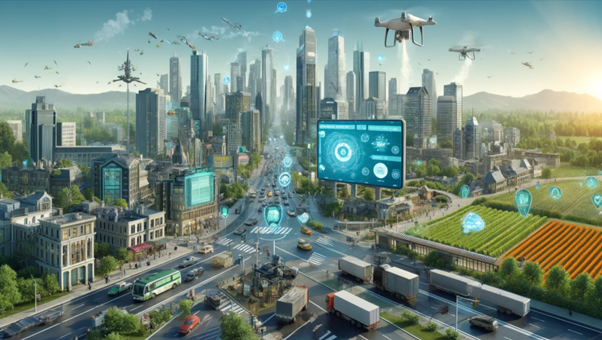🔥 Introduction to Lidarmos
What is Lidarmos?
Lidarmos is a term rapidly gaining traction in the tech world, particularly within the fields of mapping, autonomous systems, and spatial data analysis. At its core, Lidarmos refers to an evolved, AI-enhanced form of Lidar (Light Detection and Ranging), which uses laser pulses to create highly detailed 3D maps of environments.
The Etymology and Origins of the Term
The name “Lidarmos” appears to blend “Lidar” with “osmosis” or “osmos,” suggesting a seamless integration of data collection and intelligent sensing. It symbolizes not just a tool, but a system that absorbs, processes, and interprets spatial data intelligently.
🚀 The Technology Behind Lidarmos
Lidar Basics Explained
How Lidar Works
Lidar systems emit laser beams that bounce off objects and return to a sensor. By calculating the time it takes for the light to return, the system can determine distances with extreme accuracy.
Key Components of a Lidar System
-
Laser source
-
Scanner and optics
-
Photodetector and receiver electronics
-
GPS and IMU units for geolocation
Evolution from Traditional Lidar to Lidarmos
Unlike standard Lidar, Lidarmos incorporates machine learning, real-time processing, and cloud-based analytics. It doesn’t just scan—it interprets, learns, and adapts.
🏭 Applications of Lidarmos in Various Industries
Automotive Industry and Self-Driving Cars
Self-driving vehicles rely heavily on Lidar, and Lidarmos enhances this by providing AI-powered decision-making in real-time, improving safety and navigation.
Environmental Monitoring and Climate Research
From monitoring glacier melt to tracking deforestation, Lidarmos provides detailed topographic maps that help researchers observe environmental changes with unmatched clarity.
Urban Planning and Smart Cities
Smart cities need smart mapping. Lidarmos allows city planners to analyze traffic flow, infrastructure needs, and zoning with incredible precision.
Archaeology and Heritage Preservation
Lidarmos can uncover hidden ruins without excavation, mapping layers beneath dense forests or urban structures using pulse-penetrating technology.
Drones and Aerial Mapping
Equipping drones with Lidarmos sensors opens up possibilities in agriculture, surveillance, and rescue missions, especially in hard-to-reach terrains.
🎯 Advantages of Using Lidarmos
Precision and Accuracy
Lidarmos offers centimeter-level accuracy, crucial in tasks like autonomous driving and infrastructure development.
Real-Time Data Collection
No more waiting for data to be processed later—Lidarmos allows instant data visualization and decision-making.
Enhanced Safety and Efficiency
By eliminating blind spots and reducing human error, Lidarmos contributes to safer roads, workspaces, and exploration missions.
⚠️ Challenges and Limitations
High Cost of Implementation
Lidarmos systems are currently expensive, limiting access for smaller companies or developing nations.
Weather and Environmental Constraints
Rain, fog, and heavy snow can scatter laser pulses, reducing accuracy. However, innovations are underway to mitigate these.
Data Overload and Processing Requirements
The sheer volume of data generated demands powerful processors and large storage solutions, which may increase costs and complexity.
📊 Lidarmos vs Traditional Mapping Technologies
Lidar vs Radar vs Photogrammetry
-
Lidar: Laser-based, highly accurate
-
Radar: Uses radio waves, better in poor visibility
-
Photogrammetry: Uses images, less accurate for depth
Why Lidarmos Stands Out
It combines the best of all three with the added power of AI. It’s not just passive—it learns and optimizes.
🔮 Innovations and Future of Lidarmos
AI Integration in Lidarmos
Future Lidarmos systems will leverage deep learning models to classify objects, predict movements, and suggest actions.
Miniaturization and Cost Reduction
Smaller, cheaper sensors are being developed to bring Lidarmos to consumer electronics like smartphones and wearables.
5G and IoT Connectivity Enhancements
Real-time Lidarmos data streaming over 5G networks will empower IoT devices to make smarter decisions instantly.
🧠 Choosing the Right Lidarmos Solution
Factors to Consider Before Investing
-
Project scale
-
Terrain type
-
Data processing capabilities
-
Budget and ROI
Comparing Top Lidarmos Providers
Companies like Velodyne, Luminar, and Ouster are pushing the limits with cutting-edge offerings tailored to various use cases.
🌍 Real-World Case Studies
Smart Traffic Monitoring in Europe
Lidarmos is being used to monitor traffic congestion and optimize signal timings, reducing commute times by up to 20%.
Forest Management in the Amazon
Scientists are using Lidarmos drones to monitor illegal logging and track biodiversity in real-time.
Coastal Erosion Tracking in Asia
Coastal communities are using Lidarmos to analyze shorelines and prepare for rising sea levels and erosion threats.
🧾 Conclusion
Recap of Lidarmos’ Significance
From city planning to climate studies, Lidarmos is reshaping how we interact with the world. It’s faster, smarter, and more precise than any mapping technology before it.
Final Thoughts on Embracing the Technology
As costs come down and capabilities increase, Lidarmos will likely become a household name—transforming not just industries, but our daily lives.
❓ FAQs
1. What makes Lidarmos different from traditional Lidar?
Lidarmos integrates AI and real-time analytics, offering faster, smarter, and more adaptable mapping.
2. Can Lidarmos be used on smartphones or consumer gadgets?
Yes, miniaturized versions are being developed for integration into consumer electronics.
3. Is Lidarmos safe to use in public environments?
Absolutely. The laser pulses used are non-harmful and operate within regulated safety limits.
4. How accurate is Lidarmos compared to GPS?
While GPS can have a few meters of error, Lidarmos offers centimeter-level accuracy.
5. Are there open-source platforms available for experimenting with Lidarmos?
Some startups and universities offer open-source datasets and software for research and prototyping.

